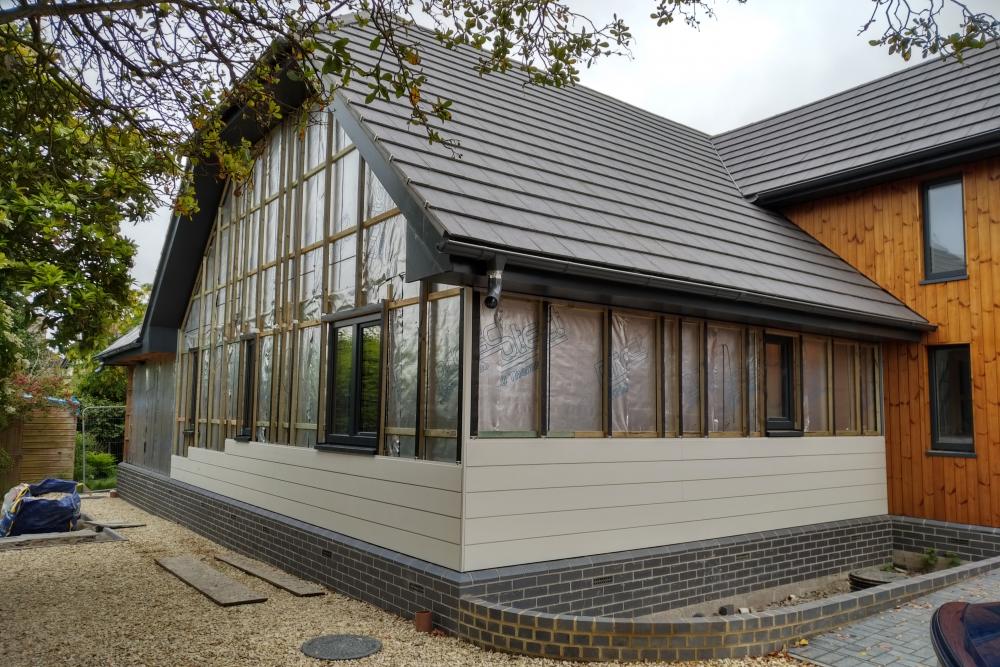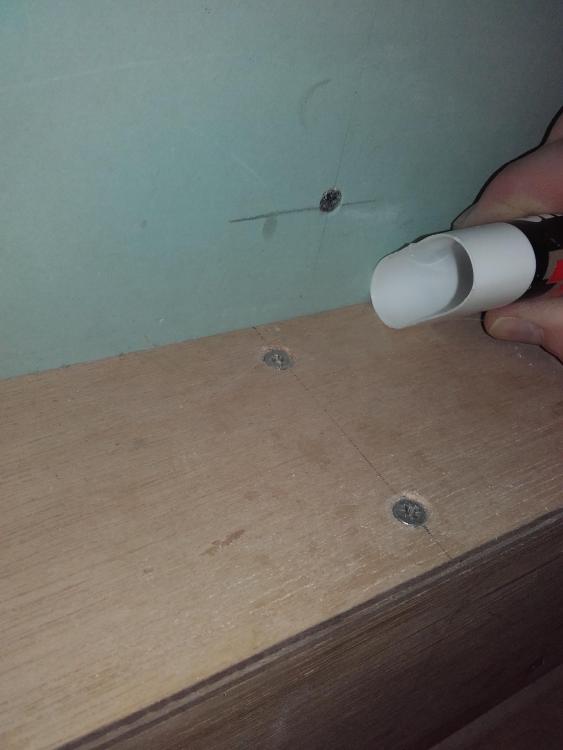Leaderboard
Popular Content
Showing content with the highest reputation on 11/01/17 in all areas
-
Oh well that's the first row and a half stuck on so guess I've made my choice (would have done more, but the baby woke up and I had to down tools). In the end it did come down to a bit of trial and error, seeing what starting point would avoid funny little bits of tile anywhere. With these wee tiles, with their bevel, and with the brick bond, there's precius little room for manoeuvre It must have been something I said to her. Oh hang on I forgot to buy her a bday present this year, that'll be it By the way it turns out that my sketchup model is way off- the window has actually worked out to be exactly, to the mm, centreline between the LH wall and the edge of the shower tray. So I'm going to end the tiles on that line, and it will look as though I planned it that way all along!2 points
-
1 point
-
Hi, Nice to see someone else in Edinburgh. That panelling is made to be waterproof not to take weight, it certainly won't hold screws well. It's not clear what you are installing here, you said a quartz top then you said a cabinet. Does the top sit on a cabinet underneath or do you mean a frame that goes back to the wall? Anything supported from the wall is going to need a frame to take the weight, you would probably have to break into the plasterboard and create a frame inside the wall connected to the studs that are there. I have a wall hung double basin and cabinet where they built a small step into the wall to support it at the back, but again if there is no frame in the wall it will be hard to build something like this with nothing to attach it to. Is the wall going to be tiled? Without more framing, anything wall supported would probably cause the wall to bow and the tiles to pop. Do you have a picture of that you want to install?1 point
-
It sounds like you have what I call an "egshell" wall. Basically 2 sheets of plasterboard about 50mm apart, with a lattice of cardboard between them. the timber battens will be at the joint every 1200mm Your bathroom counter should be self supporting from the floor. If necessary fit additional feet or a more solid support for the base (assuming it is hidden by a plinth) so all the fixing to the wall does is stops someone pulling it over. If you can get one fixing into a timber upright I would have thought that was adequate.1 point
-
Tricky one.. https://www.gov.uk/government/publications/vat-notice-708-buildings-and-construction/vat-notice-708-buildings-and-construction Edit: What's with this editor? I only put quotation tags around the bit I was quoting and it's enclosed the lot and added lots of white space. So if it's part of your alarm system then yes. If it's a gate opener then no. When I did my VAT reclaim the text I put on the spreadsheet didn't always exactly match what was written on the receipt. This was the case where I thought that what was written on the receipt was difficult to understand or open to misinterpretation.1 point
-
@Crofter I'd either: (A) take it past by the 3 inches then so that the tiles just cover all your holes, or maybe (B) the potential alternative would be to match the width of painted plaster that's on the left side of your window with the same width of painted plaster on the right side and tile up to that line? Your window would then sit symmetrically in the plastered section of wall.1 point
-
Get a hozelock spray bottle and fill it 50/50 with PVA and water. Spray it a few times until saturated and leave to dry. Then do it again a bit later. That seals the surface and locks any loose material in place. ?1 point
-
Just fitted this Salus auto balancing valve, but fitted in a slightly unusual way, as all our loops are run as a single circuit. I fitted it in place of the normally closed thermal actuator valve that was on the return end of the manifold, not as one of the loop control valves as Salus intend it to be used. It was a direct replacement for the existing normally closed thermal head, so was easy to fit. It comes with two clip on temperature sensors (not marked - either can be flow or return) and if these are fitted it will try and maintain a 7 deg C temperature differential across them, whether heating or cooling, it seems. At first I just left these dangling, fitted the valve, wired it up and tried it out. It's much faster than the thermal actuators, and uses about 1/4 of the power. The actuator takes less than 30 seconds to motor from fully closed to fully open, and seems to close using a wound spring, as with the power off the gears can be heard winding the pin down to close the valve. There's no hammer or any adverse effects at all, the UFH just comes on a great deal faster (the old thermal actuator was taking around 8 minutes to open fully). As this device tries to maintain a 7 deg differential between the two remote clip on temperature sensors, I tried it out, with the sensors clipped to the nearest to flow and return pipes. Our floor was at around 19.9 deg C, and the flow on the mixer was initially set to 25 deg C (it's usually between 25 and 26 deg C, about as low as it will go). All worked OK, so I then opened up the mixer valve so that it was letting in a flow temperature of around 38 to 40 deg C, straight from the ASHP. This is where things got interesting, as the Salus valve on the return motored a few times, then set the manifold flow temperature at a very steady 26 deg C! Normally, with the mixer valve wide open I'd easily see the manifold get up very close to the ASHp flow temperature. So, the bottom line is that this new valve not only turns the UFH on and off a great deal faster, but it also does the job of the mixer valve as well, IF it's fitted where ours is, as the return valve on the end of the manifold. This seems like a very neat solution to me, as it does away with the need for a thermostatic mixer valve - right now I'm leaving mine set on maximum, but I may remove the remote sensing head and just fit a blanking cap to hold that valve wide open. I didn't anticipate being able to get such good control with this valve, although I'm not at all sure that Salus envisioned anyone would use one like this! Thanks @Nickfromwales for the head-up on these valves.1 point
-
Special tool? Nah, don't bother. On a long run like that an EMPTY silicone tube is what you want. Put a drop of Fairy in a jug with some water. Cut the end off the silicone tube SQUARE. None of that 45deg b@llocks. Flatten the end a bit and dip the in the soapy water. Go along your silicone and it leaves a lovely neat filet. Excess collects in the empty tube. Periodically re-dip in the water: Maybe I'll do a video! Taught to me by a Moldovan commercial glazing fitter.1 point
-
@JSHarris Wunda just supplied me with a new manifold for a customer to replace the mess that some goon fitted. They recommended the Salus auto balancing actuators which open with stepper motors, a lot quicker than the wax heated ones. Literally open to closed in a few seconds. Manufacturers patter Wundas patter and cost These have a pair of capillary wires, one for flow and one for return, to sense temp differentials and balance accordingly. Under max flow I'd say the longest I waited for fully open / closed was around 30 seconds as they struggled a bit against full pump force on one circuit open. Much quicker when the pump potential was divided.1 point
-
As an architect I think it’s crazy trying to design a house when you don’t even have a site in mind. You’ve no idea which way the house faces, where the sun rises, where neighbours may overlook, do you overlook the neighbours, if the site is even flat, where are the views, where is the road, is the road noisy or busy, are all the surrounding houses bungalow or all dormer which could influence planners, is it a conservation area, do any planning restrictions apply, etc. If you have your ‘perfect’ house planned and then get a site you could end up putting a house on a site which is totally unsuitable and it will be only after you’ve built and move in that you realise this. If you want to think about ideas, design, layouts, materials, etc then set up a Pintrest account and start making albums of what you like and what you don’t like. Use a general cost per meter square to work out the costs for now. The site you eventually pick could have very poor access or require a huge amount of ground works so getting a cost of a ‘perfect’ house now isn’t appropriate. Sorry to be negative but this is a huge investment and you want to get it right.1 point
This leaderboard is set to London/GMT+01:00






